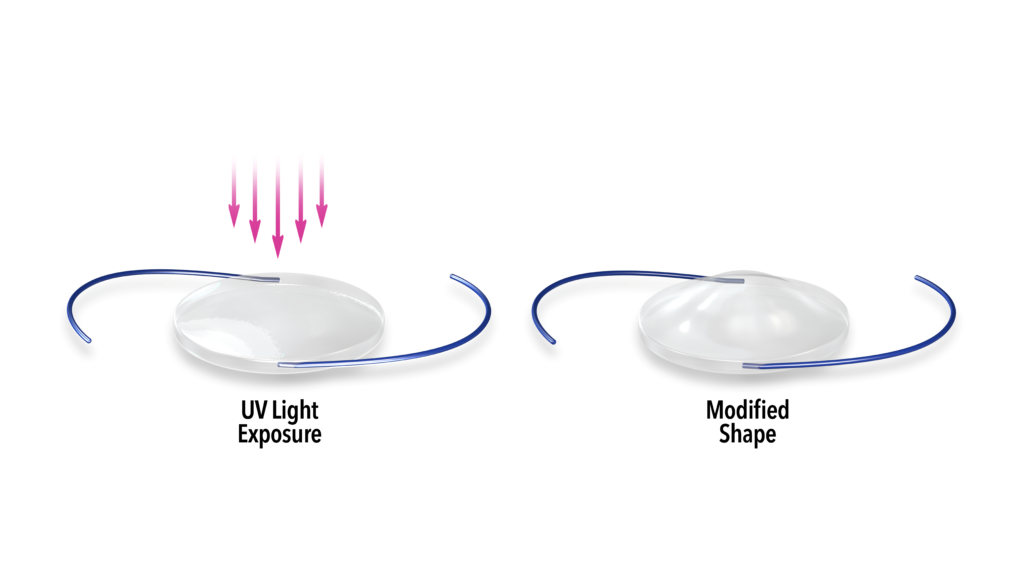It used to be over the past six decades that the only choice for a cataract surgery implant was the standard ‘monofocal’ lens implants or intraocular lenses (IOLs). They still offer good functional ‘distance’ vision, but reading glasses are almost always needed for near vision.
If you want to be less dependent on eyeglasses or contact lenses, or if you have astigmatism, then the FDA approved Premium Intraocular Lenses (IOLs) are a better choice. Because of the advanced technology utilized in these Premium IOLs, your vision may be better than it would be if the standard IOL was used.
Once you have cataract surgery, you cannot change your mind to upgrade to a Premium IOL. That is why it is so important to really think about this decision ahead of time. At The Eye Associates, we strive to answer all your questions and help you through this decision process. We understand that your lifetime of good vision depends on it.
Monofocal
Correct astigmatism, giving good distance vision but you will still require reading glasses.
Toric
Corrects astigmatism
Multifocal
Work somewhat like a progressive or bifocal eyeglass lens by offering you an expanded range of vision, distance and near.
Trifocal
Have different zones on the lens to correct different types of vision
Multifocal and Extended Depth of Focus
Work somewhat like a progressive, bifocal, or trifocal lens by offering you an expanded range of vision, distance, and near.
A lens with a single focal point, designed to correct cataracts and provide distance vision while offering enhanced image quality
| Near | |
| Intermediate | |
| Distance | |
| Astigmatism |
A lens with a single focal point, designed to correct both cataracts and pre-existing astigmatism, providing distance vision
| Near | |
| Intermediate | |
| Distance | |
| Astigmatism |
A premium lens designed to correct cataracts and presbyopia in order to provide a full range of vision for patients
| Near | |
| Intermediate | |
| Distance | |
A lens with multiple focal points, designed to correct cataracts and provide clear vision at various distances, including near, intermediate, and far, while offering enhanced image quality.
| Near | |
| Intermediate | |
| Distance | |
| Astigmatism |
A lens with multiple focal points, designed to correct cataracts and provide clear vision at near, intermediate, and far distances, while offering enhanced image quality.
| Near | |
| Intermediate | |
| Distance | |
| Astigmatism |
The Light Adjustable Lens™ (LAL®) is the first and only lens that can be customized after cataract surgery—because we believe your vision should be exactly what you want. Now you can experience your vision, then refine it. So your vision will truly be yours.
With other lenses, you have to make a lot of decisions about the vision you want before your cataract surgery. Once implanted, those lenses can’t be changed; they’re what’s known as “fixed.” The Light Adjustable Lens, however, is an adjustable lens. This means that the only decision you have to make before your surgery is to choose the Light Adjustable Lens. The rest can be made after your surgery once your eye has healed. You and your surgeon then have the ability to adjust the lens and optimize your vision based on your unique preferences and lifestyle requirements. So you will truly have vision that is just for you.
The Light Adjustable Lens is made of a special photosensitive material that changes the shape and power of your implanted lens in response to ultraviolet (UV) light to optimize your vision.
The Light Delivery Device (LDD) non-invasively delivers this UV light to precisely reshape your lens based on the visual correction that is needed to target your custom prescription.

AcrySof IQ PanOptix IOL is the first and only Trifocal lens implant in the US. This IOL offers patients an outstanding range of vision. When PanOptix patients were asked if they needed eyeglasses after cataract surgery with this implant, 80.5% of them said that they never wore glasses, and another 11.4% said that they rarely used them.
The biggest thing that makes the Vivity lens different is it uses proprietary, non-diffractive technology called X-Wave. X-Wave technology is unique because it uses all available light around it to create an extended range of vision.
There are no gaps in sight or multiple separate focal points that split the wavefront, which other diffractive multifocal lenses do. Instead, with the Vivity lens, you can see exceptionally well at a distance and intermediate distances while still seeing close-up things.
You can even see well in any lighting, whether it’s bright or dim. The Vivity lens will protect your eyes from damaging UVA and UVB rays from the sun and filters the blue light emitted from digital devices like your television or cell phone.
The first step to find out if you need cataract surgery is a comprehensive eye exam with one of our Board Certified Physicians at The Eye Associates.